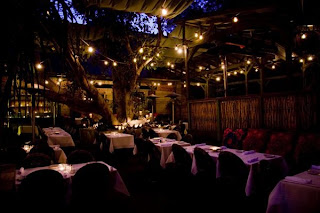Cliff’s Edge
3626 W. Sunset Blvd., Los
Angeles, CA 90026 (Silverlake)
This week’s Bar Fly Review covers a place with such a unique blend of
characteristics – characteristics that cater to literally every aspect of one's
psyche (the inner child, the hopeless romantic, the French sophisticant, the
30-something bar fly, etc.) – it’s nearly impossible to accurately describe (in
a way that doesn’t seem nuts). But here
goes…
Imagine George of the Jungle relocated to
Paris, graduated from the French Culinary Institute, uprooted his treehouse, moved
to the city, planted it inside an abandoned building and turned it into an
upscale restaurant and bar. A literal
urban jungle. Cliff’s Edge is something
like that. But even better.
Based on my requirements for a restaurant,
Cliff’s Edge scores a 100% on ambience alone.
First, the place is hidden. Legitimately
hidden – in a dark grey, unmarked, windowless, unlit building adjacent to an
empty parking lot, on the "other" Sunset Blvd. in Silver Lake, east
of Sunset Junction. Trust me, even with
your iPhone or GPS, you'll drive past it. You won't even be certain you found the place
until you enter through a tall bamboo archway (which looks like something
Indiana Jones would lead you through, right before you die) around the side of
the building in the back of the parking lot.
Second, the restaurant is essentially in a treehouse, within a building. The place is structured as a multi-tiered
collection of bamboo booths and wooden tables encircling a giant fig tree which
branches out amongst the tables and booths as it grows high above the outside
walls, providing a natural canopy over the roofless building. The “walls” (if they exist at all?) are
completely engulfed in lush vegetation, giant palms overhang the nooks and
corners, and the small lights strung conservatively within the tree’s branches
make it truly appear as though you’ve been whisked away to an exotic jungle
oasis. (Los Angeles Magazine describes
the place as having “a romantic (but not too romantic)…sprawling hillside
patio…[that]…lights up at night like the Swiss Family Robinson’s
cafeteria.” Being from Generation X, I
prefer the George of the Jungle imagery.
But you get the idea.)
Third, the restaurant is lit by fire
pits. FIRE PITS! (LA has a dearth of open-air fire pits.) Fire pits alone make a good place great. But fire pits in a treehouse restaurant
hidden within a concrete building? That
takes a great place somewhere past epic.
Fourth, the place also has a bar. But not just any bar – a bar hidden through
the restaurant, past a large wall made of repurposed wooden pallets. And not just a hidden bar – a rustic/modern enclave
with exposed wooden structural beams, bordello chandeliers, and a mosaic of
large French mirrors. And if the
atmosphere wasn’t good enough, the bar has a host of signature cocktails, beer
(bottle and draft), wine, and amazing happy hour deals ($3 beers).
Lastly, the food is incredible, in both price
and taste – so much so that Cliff’s Edge was recently named “Best of LA Winner”
by Los Angeles Magazine, after bringing on James Beard-nominated chef Benjamin
Bailly. The menu is extensive, eclectic,
and delicious, offering something for everyone.
So whether you’re looking for a romantic candlelit
grotto to spend the night with someone special, a glass of wine in a modern-ish
French-themed bar, a great place for happy hour, or you just want to follow Dr.
Jones to the treetop Ewok village and share a meal with your Jane, Cliff’s Edge
won’t disappoint. [Yes, that was a hybrid Indiana Jones-Star Wars-Tarzan
reference.] Cliff’s Edge truly is one of
the best spots in LA. Make sure to go. If you can find it.
